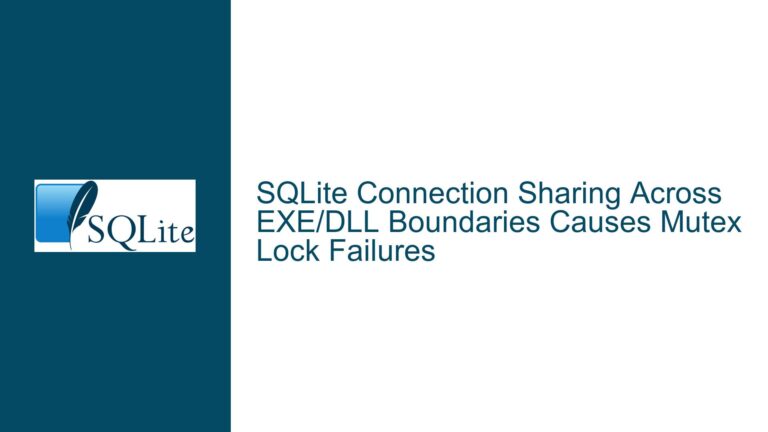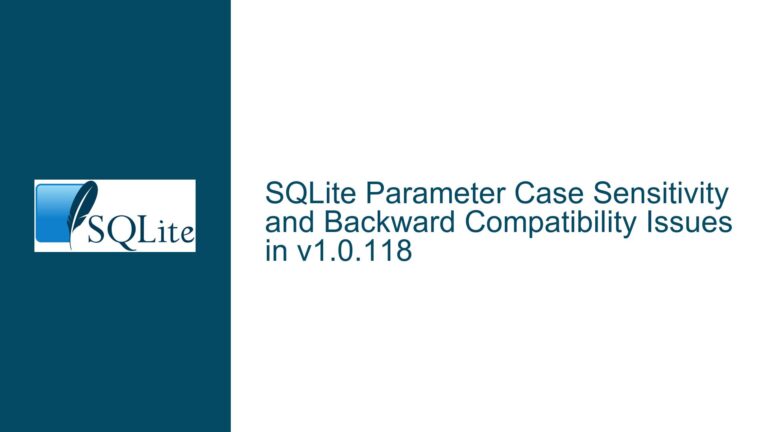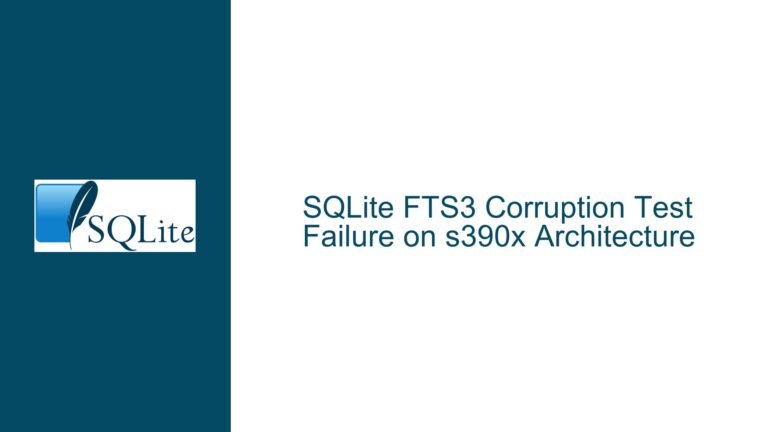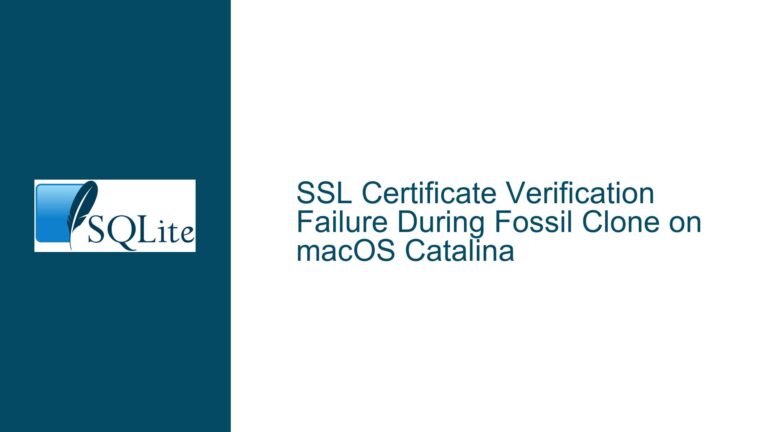Updating SQLite to 3.33.0 in Android Apps with SugarDB Integration
SQLite Version Mismatch and WAL Journaling Issues in Android Apps
When developing Android applications that rely on SQLite for database management, developers often encounter challenges related to the built-in SQLite version provided by the Android OS. The built-in SQLite version may not always align with the latest features or bug fixes available in the upstream SQLite releases. This discrepancy can lead to issues, particularly when using advanced features like Write-Ahead Logging (WAL) journaling mode. In this scenario, the developer is using SQLite version 3.25.2, which is bundled with the Android OS, but desires to upgrade to SQLite version 3.33.0 to resolve WAL-related issues and leverage newer features.
The primary concern revolves around the compatibility of the WAL journaling mode with the SQLite version. According to the SQLite.org documentation, databases in WAL mode can only be accessed by SQLite version 3.7.0 or later. While the current version (3.25.2) meets this requirement, upgrading to 3.33.0 could provide additional stability and performance improvements, especially in scenarios where the app is experiencing issues with WAL mode. However, the upgrade process is not straightforward, particularly when the app uses an ORM (Object-Relational Mapping) library like SugarDB, which abstracts away much of the direct SQLite interaction.
The developer’s questions highlight three critical areas of concern: the step-by-step process for updating the SQLite version, the potential for breaking existing code, and the risk of disrupting the integration between SQLite and SugarDB. Each of these concerns requires a detailed exploration to ensure a smooth transition to the newer SQLite version.
Challenges in Upgrading SQLite in Android with SugarDB Integration
Upgrading the SQLite version in an Android app involves several layers of complexity, particularly when an ORM like SugarDB is in use. The built-in SQLite version in Android is tightly coupled with the OS, meaning that simply updating the SQLite library is not as straightforward as replacing a standalone library in a desktop application. Additionally, SugarDB, like many ORMs, relies on specific SQLite features and behaviors, which may change between versions. This introduces the risk of breaking existing functionality or causing unexpected behavior in the app.
One of the primary challenges is the potential for breaking changes in the SQLite API or behavior. While SQLite is known for its backward compatibility, there are instances where newer versions introduce changes that could affect existing code. For example, changes in the way WAL mode handles concurrent transactions or how certain SQL functions are implemented could lead to subtle bugs or performance issues. These changes might not be immediately apparent but could manifest under specific conditions, such as high concurrency or large datasets.
Another challenge is the integration between SQLite and SugarDB. SugarDB abstracts much of the direct SQLite interaction, providing a higher-level API for database operations. This abstraction layer can sometimes hide underlying issues or make it difficult to diagnose problems related to the SQLite version. If the upgrade to SQLite 3.33.0 introduces changes that affect how SugarDB interacts with the database, it could lead to issues such as corrupted data, failed transactions, or performance degradation.
Finally, the process of updating the SQLite version itself is non-trivial. Android does not provide a built-in mechanism for replacing the system SQLite library with a custom version. Developers must resort to workarounds, such as bundling a custom SQLite library with the app or using third-party libraries that provide updated SQLite versions. Each of these approaches has its own set of trade-offs and potential pitfalls, which must be carefully considered to ensure a successful upgrade.
Step-by-Step Guide to Upgrading SQLite and Ensuring Compatibility with SugarDB
To address the challenges of upgrading SQLite in an Android app with SugarDB integration, a systematic approach is required. This approach involves several steps, each designed to minimize the risk of breaking existing code and ensure a smooth transition to the new SQLite version.
Step 1: Assessing the Current Environment
Before attempting any upgrade, it is crucial to thoroughly understand the current environment. This includes identifying the exact version of SQLite being used, the specific features and configurations (such as WAL mode), and how SugarDB is integrated into the app. Developers should review the app’s database schema, queries, and transaction patterns to identify any areas that might be sensitive to changes in the SQLite version.
Step 2: Bundling a Custom SQLite Library
Since Android does not allow direct replacement of the system SQLite library, one common approach is to bundle a custom SQLite library with the app. This can be achieved by using libraries like SQLiteAndroidWrapper or SQLCipher, which provide updated SQLite versions and can be integrated into the app’s build process. The steps for integrating a custom SQLite library include:
- Adding the custom SQLite library as a dependency in the app’s build.gradle file.
- Modifying the app’s code to use the custom SQLite library instead of the system SQLite library.
- Testing the app to ensure that the custom SQLite library is correctly loaded and used.
Step 3: Testing for Compatibility with SugarDB
Once the custom SQLite library is integrated, the next step is to test for compatibility with SugarDB. This involves running the app’s existing test suite, as well as additional tests designed to exercise the database layer under various conditions. Developers should pay particular attention to areas where SugarDB interacts with SQLite, such as schema migrations, query execution, and transaction management.
Step 4: Handling Potential Breaking Changes
If the upgrade to SQLite 3.33.0 introduces breaking changes, developers must identify and address these changes before deploying the updated app. This might involve modifying the app’s code to accommodate changes in SQLite’s behavior, updating SugarDB to a version that is compatible with the new SQLite version, or implementing workarounds for specific issues.
Step 5: Monitoring and Optimization
After the upgrade is complete, it is essential to monitor the app’s performance and stability to ensure that the new SQLite version is functioning as expected. This includes monitoring for any unusual behavior, such as increased crash rates or performance degradation, and optimizing the app’s database usage to take full advantage of the new SQLite version’s features.
Example Table: SQLite Version Compatibility with SugarDB
| SQLite Version | SugarDB Compatibility | Notes |
|---|---|---|
| 3.25.2 | Fully Compatible | Built-in version in Android OS |
| 3.33.0 | Requires Testing | Potential breaking changes in WAL mode |
| 3.7.0 | Compatible | Minimum version for WAL mode support |
Conclusion
Upgrading the SQLite version in an Android app with SugarDB integration is a complex process that requires careful planning and execution. By following the steps outlined above, developers can minimize the risk of breaking existing code and ensure a smooth transition to the new SQLite version. While the process involves several challenges, the benefits of using the latest SQLite version, such as improved performance and stability, often outweigh the risks. With thorough testing and monitoring, developers can successfully upgrade their app’s SQLite version and take full advantage of the latest features and improvements.






